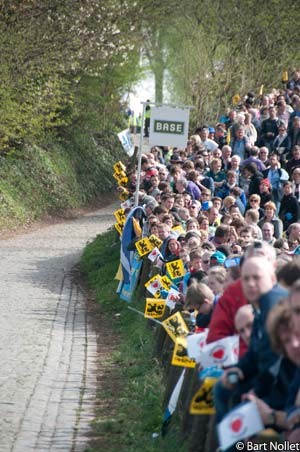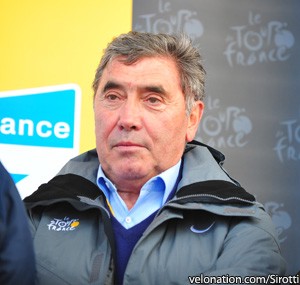The Flanders public appears to be dead set against the course change, but those involved have a more balanced view
 This week Flanders Classics, the organiser of the Ronde van Vlaanderen – the Tour of Flanders – announced that the race’s finish would move from Meerbeke, a suburb of Ninove, to Oudenaarde in the centre of the Flemish Ardennes. Not only would the finish line be moving away from the iconic rising finishing straight of the Halsesteenweg though, but the race would be also missing out one of its most famous climbs, the Muur van Geraardsbergen.
This week Flanders Classics, the organiser of the Ronde van Vlaanderen – the Tour of Flanders – announced that the race’s finish would move from Meerbeke, a suburb of Ninove, to Oudenaarde in the centre of the Flemish Ardennes. Not only would the finish line be moving away from the iconic rising finishing straight of the Halsesteenweg though, but the race would be also missing out one of its most famous climbs, the Muur van Geraardsbergen.
Unlike fellow cycling monuments Milano-Sanremo, Paris-Roubaix and Liège Bastogne-Liège, the Ronde van Vlaanderen and the Giro di Lombardia are not bound by specific start and finish points. Both races have changed a great deal in their long histories, but the Ronde’s problem seems to be that it has kept to the same finish for the past 39 years; more than two-fifths of its 94 editions.
While Lombardia has happily switched its finishing point between Milano, Monza, Bergamo and Como over the years – and will finish in Lecco for the first time in 2011 – ‘Vlaanderens Mooiste’ has been so entrenched in Meerbeke that it’s hard for many to imagine anything else.
As well as switching from Meerbeke to Oudenaarde, and skipping the Muur, the 2012 course will feature three laps of a shrinking finishing circuit as it makes its way to the finish. While it will feature seventeen climbs though, only thirteen different hills will be used, with the Oude Kwaremont and Paterberg climbed three times each. This has been greeted positively by those who acknowledge that fans will be able to see the race more than once without having to move, but not everybody is in favour.
The mere presence of a circuit in the race, albeit a shrinking one, has caused some critics to compare it to a ‘kermesse’ [criterium – ed], whole others worry that it may give organisers the opportunity to charge for access to certain parts of the course. Others say that, unlike Amstel Gold that has to re-use climbs because of a shortage in the area, Flanders is peppered with short, sharp bergs and it makes no sense to use some more than once at the expense of others.
Some say that forcing the peloton up the fearsome Paterberg three times will be too much, particularly in the wet. Others, including this author, also worry that sending the men’s peloton around the finishing zone three times might make it difficult to accommodate the women’s race, which has run in parallel since 2004.
Belgium says ‘no’, the riders say ‘maybe’
“We think that we have made the right choice and ask the audience for this one chance,” race organiser Wim Van Herreweghe told Het Laatste Nieuws. “Experience it first before you judge.”
According to Het Laatste Nieuws though, an online poll of more than 25,000 Belgians saw only nine percent of them in favour of the new course. A number of riders, past and present, have been also been expressing their opinions.
Two-time winner Stijn Devolder (Vacansoleil-DCM) is one rider that is firmly in the ‘no’ camp, even though he feels that the new course will suit him better.
 “Climbing the Oude Kwaremont and the Paterberg three times in the finale is probably in my favour,” Devolder told Het Laatste Nieuws, “but I believe that the organisers made a wrong choice by simply replacing the old finish. The Muur van Geraardsbergen and the Bosberg can not be erased from the Ronde.”
“Climbing the Oude Kwaremont and the Paterberg three times in the finale is probably in my favour,” Devolder told Het Laatste Nieuws, “but I believe that the organisers made a wrong choice by simply replacing the old finish. The Muur van Geraardsbergen and the Bosberg can not be erased from the Ronde.”
“Besides, the finish must remain in Meerbeke,” he added. “I could win ten times in Oudenaarde, but it would never be the same feeling as finishing the job in Meerbeke.”
The legendary Eddy Merckx is another two-time winner, but is a little more neutral on the subject of the new course than Devolder. Having been an advisor to the race organiser on the question of the route change, the Cannibal unsurprisingly sees the merits of the old and new finishes.
“One is the one, the other is the other,” he told Het Nieuwsblad. “We knew the value of the old course, and we are now waiting to see what the new one gives us. Meerbeke yielded exciting finals, as we know.
“It will certainly not be any less difficult,” Merckx continued. “It’s a very tough course, which goes really deep into the finish. I rode it round again, I think the combination of the Oude Kwaremont and Paterberg is harder than the Muur and the Bosberg.
 “I give it to Fabian Cancellara,” he said. The Swiss says we need to wait and see whether the breakaway has as much advantage after the Paterberg as the gently sloping course from the Bosberg to Meerbeke, but I think this is dependent on the wind and the weather of the day.
“I give it to Fabian Cancellara,” he said. The Swiss says we need to wait and see whether the breakaway has as much advantage after the Paterberg as the gently sloping course from the Bosberg to Meerbeke, but I think this is dependent on the wind and the weather of the day.
“Ah, there’s a cliché that says that the riders make the race. That is actually true.”
Merckx is one of the few men that won the race in Meerbeke, in 1975, and in Gentbrugge, in 1968, which previously hosted the finish. While he sees the value of nostalgia, he also recognises the need for the new generation to create its own history.
“Next year we’ll know more,” he explained. “For example, I’d also like Milan-Sanremo [a race he won an incredible seven times – ed] to finish on the Via Roma again, if only for the grandeur of the fountain in the background, but that is now already past. We identified the Ronde with Meerbeke, but the next generation will identify this Classic with Oudenaarde,”
Commentators see the big picture but regret the lose of one of the Ronde’s fixtures
Sporza commentary team Jose De Cauwer and Michel Wuyts have the job of summarising the race and, perhaps unsurprisingly, share Merckx’s balanced view of the course change.
“The duo of the Oude Kwaremont and Paterberg is definitely tougher than the combination of the Muur van Geraardsbergen and Bosberg,” De Cauwer told Het Laatste Nieuws. “On the Paterberg, where the gradients are about 16 percent, I have seen many riders ‘die’.
“So anyway, the finale will be spicier than before.”
Like Merckx, De Cauwer reminds everyone that the race changed its starting point in 1998, to similar protest at the time.
“Well, the move of Meerbeke to Oudenaarde…” he said “We must sometimes agree to forget about living with the past. The Ronde used to start in Sint-Niklaas; people also screamed bloody murder at the time when it moved to Brugge, but is that still the case? The new finish will definitely be an adjustment for everyone.”
Wuyts too, sees the need to move forward, but is one that questions the circuit finish of the new course.
“I can follow the reasoning that the Ronde is more oriented towards the future, that Oudenaarde is a finer sight than Ninove, and the Oude Kwaremont and Paterberg will be a nice change,” Wuyts conceded. “But do you need to change a winning concept?
“That they will climb the Kwaremont and Paterberg three times, I think that’s once too often,” he continued. “Now it has three circuits, even though each of the loops gets smaller.”
Wuyts is also one of those that regret the removal of the Muur van Geraardsbergen, a climb that has featured in the race 45 times in its history.
“The Muur is, of course, the biggest loss,” he said. “I think it’s a blunder that they have removed it. The Muur was a monument to the monument; over the years it has become a place of pilgrimage.
“It seems that the Ronde has been decapitated,” he added, “but those are the first emotions. There is still some time to pass. It seems to me that the we should evaluate the new course after the first edition.”
Three-time winner Johan Museeuw is another that regrets the Muur’s removal, as he told Het Nieuwsblad.
“Of course it is unfortunate that the Muur van Geraardsbergen is no longer in the course,” he said. “It has repeatedly made the difference, it’s logical that this climb has my love and support.
“It will be a rider with a big engine and a big name that wins the Ronde van Vlaanderen of 2012,” he added.
It’s perhaps another three-time winner in Eric Leman, who also won in both Gentbrugge and Meerbeke – being the first to raise his arms on the Halsesteenweg in 1973 – to sum the new course up.
“The Ronde is and remains a monument on any course,” he told Het Nieuwsblad.